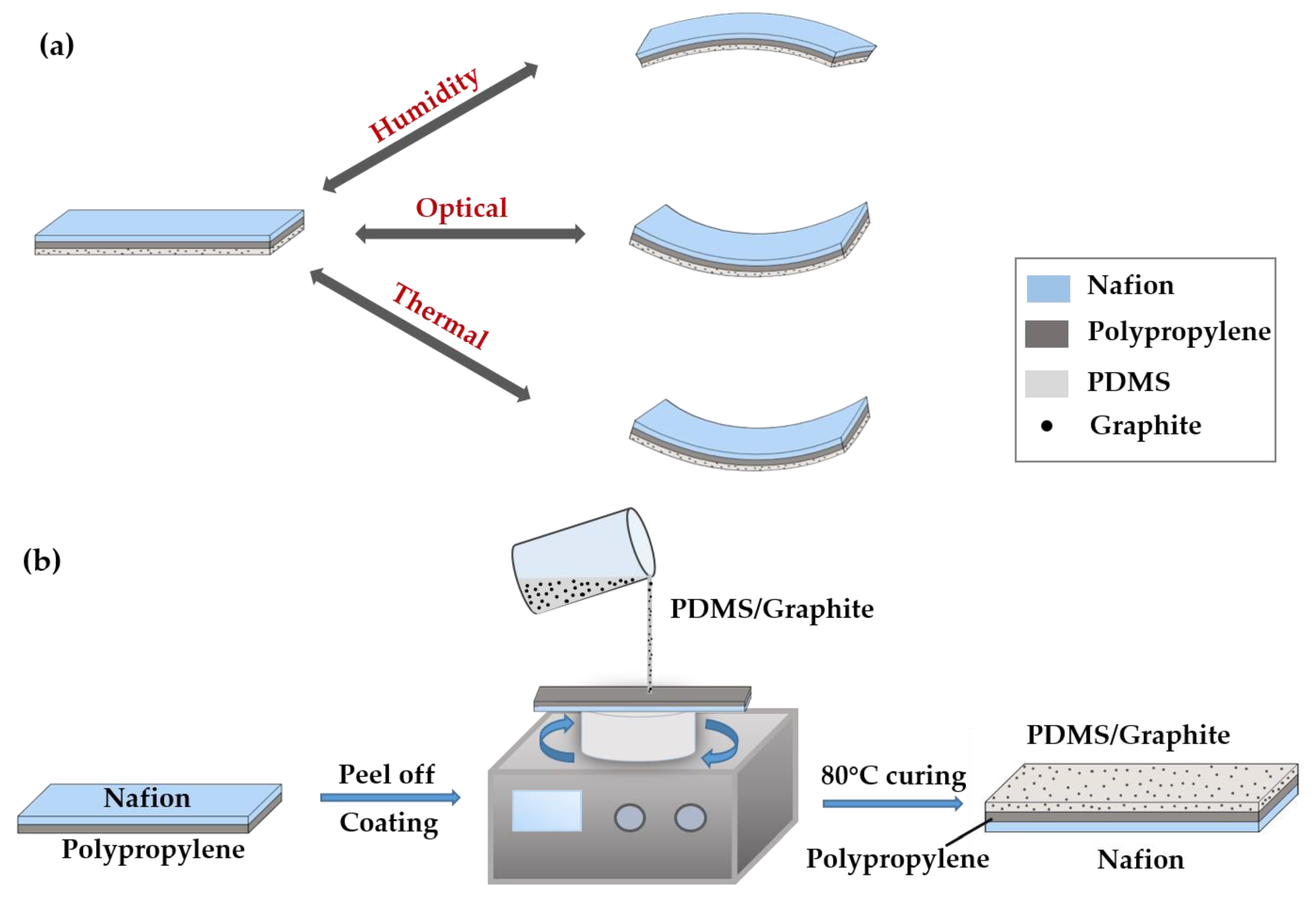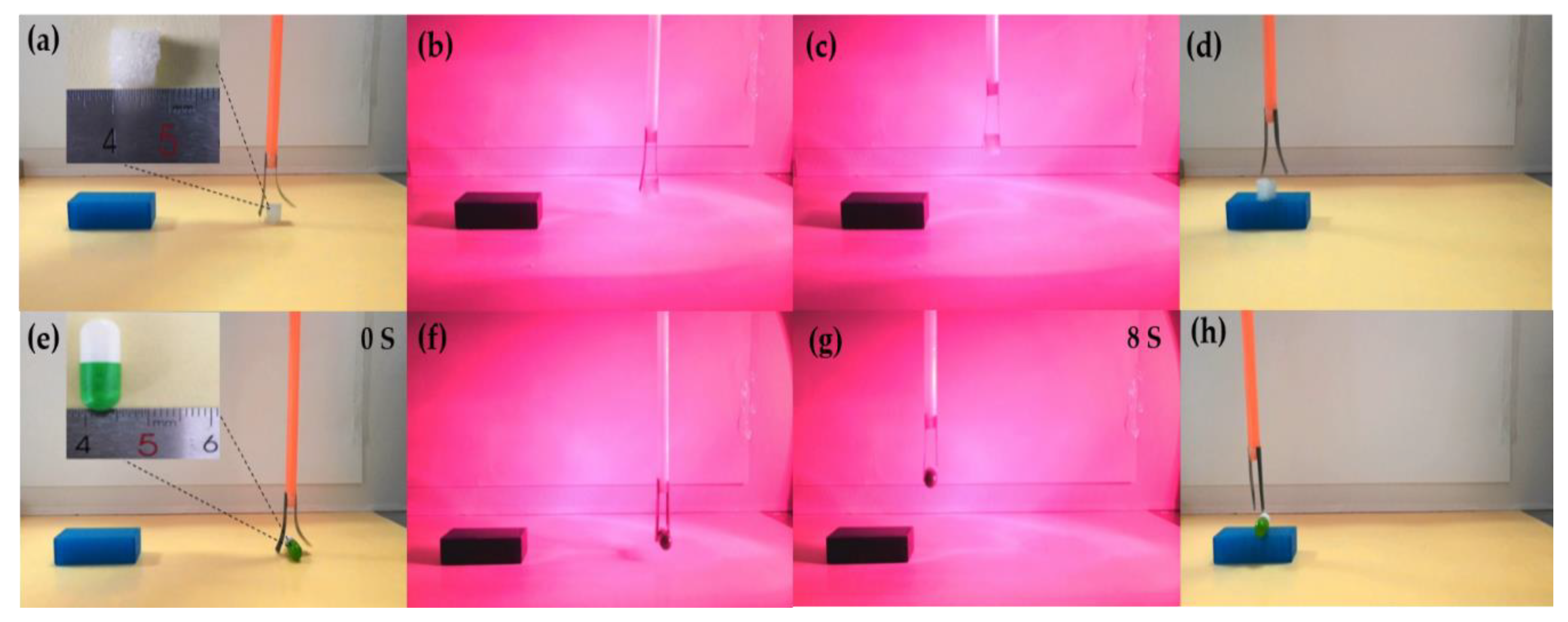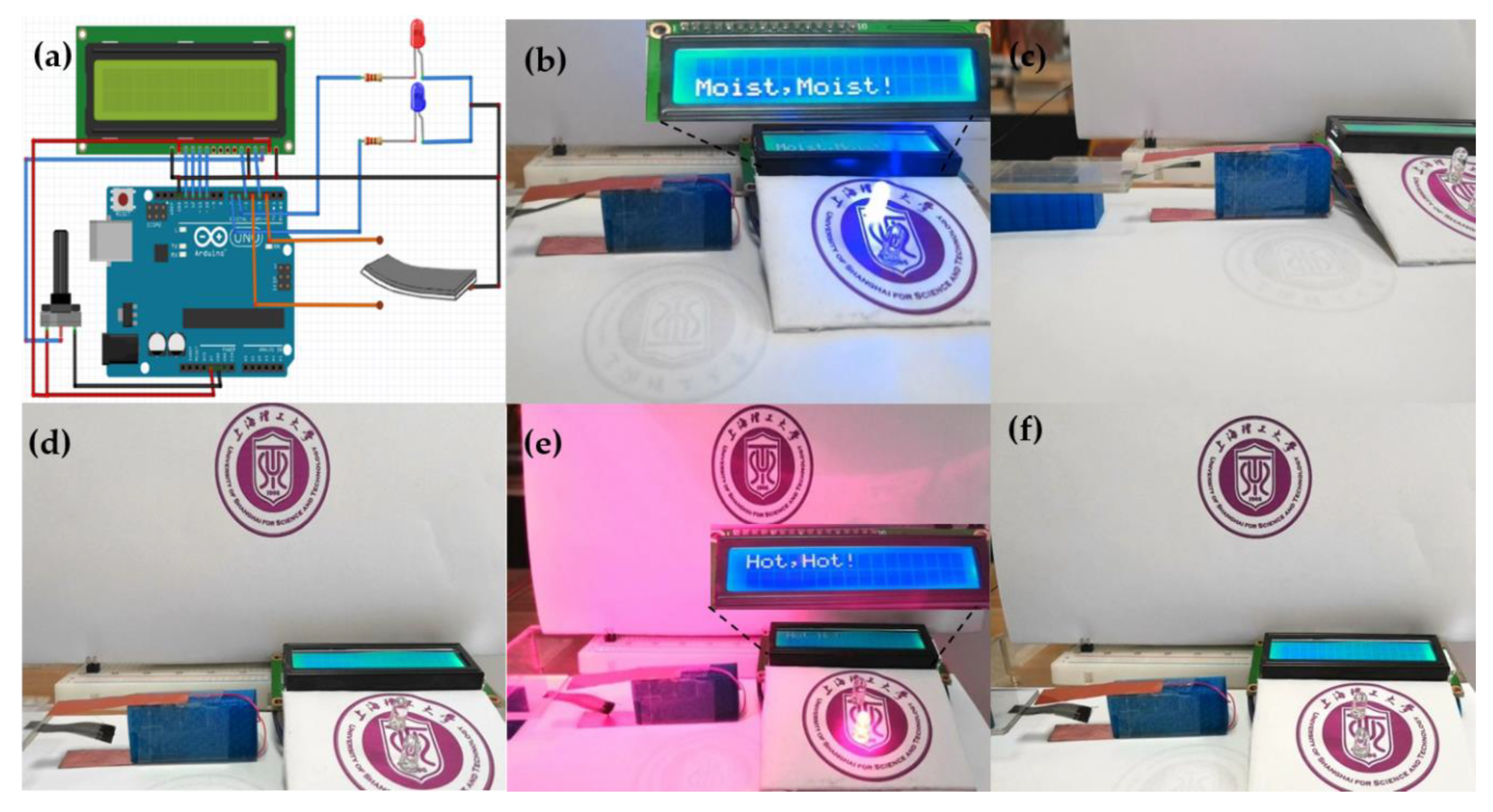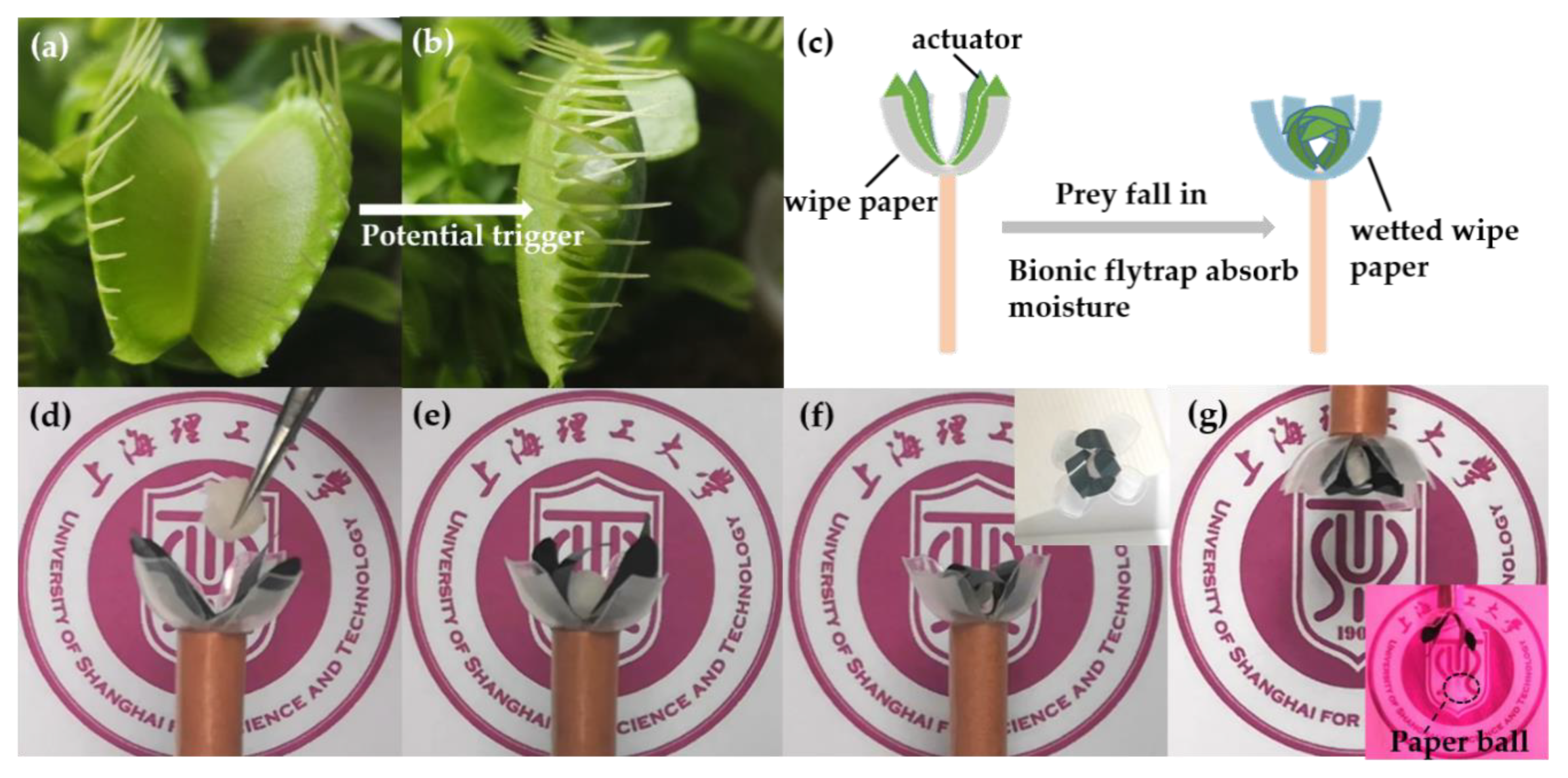Smart Devices Based on the Soft Actuator with Nafion-Polypropylene-PDMS/Graphite Multilayer Structure
Abstract
:Featured Application
Abstract
1. Introduction
2. Materials and Methods
2.1. Materials
2.2. Fabrication and Measurement of the Multilayer Membrane-Based Actuator
3. Results and Discussion
3.1. Multilayer Membrane of Humidity Responsive Deforming
3.2. Multilayer Membrane of Optical Responsive Deforming
3.3. Multilayer Membrane of Thermal Responsive Deforming
4. Multiple Stimulus-Driven Smart Devices
5. Conclusions
Author Contributions
Funding
Conflicts of Interest
References
- Kim, S.; Laschi, C.; Trimmer, B. Soft robotics: A bioinspired evolution in robotics. Trends Biotechnol. 2013, 31, 287–294. [Google Scholar] [CrossRef] [PubMed]
- Ma, M.; Guo, L.; Anderson, D.G.; Langer, R. Bio-inspired polymer composite actuator and generator driven by water gradients. Science 2013, 339, 186–189. [Google Scholar] [CrossRef] [Green Version]
- Park, S.; An, J.; Suk, J.W.; Ruoff, R.S. Graphene-based actuators. Small 2010, 6, 210–212. [Google Scholar] [CrossRef] [PubMed]
- Stuart, M.A.; Huck, W.T.; Genzer, J.; Muller, M.; Ober, C.; Stamm, M.; Sukhorukov, G.B.; Szleifer, I.; Tsukruk, V.V.; Urban, M.; et al. Emerging applications of stimuli-responsive polymer materials. Nat. Mater. 2010, 9, 101–113. [Google Scholar] [CrossRef] [PubMed]
- Hu, Y.; Wu, G.; Lan, T.; Zhao, J.; Liu, Y.; Chen, W. A Graphene-Based bimorph structure for design of high performance photoactuators. Adv. Mater. 2015, 27, 7867–7873. [Google Scholar] [CrossRef] [PubMed]
- Cheng, H.; Zhao, F.; Xue, J.; Shi, G.; Jiang, L.; Qu, L. One single graphene oxide film for responsive actuation. ACS Nano 2016, 10, 9529–9535. [Google Scholar] [CrossRef]
- Lum, G.Z.; Ye, Z.; Dong, X.; Marvi, H.; Erin, O.; Hu, W.; Sitti, M. Shape-programmable magnetic soft matter. Proc. Natl. Acad. Sci. USA 2016, 113, E6007–E6015. [Google Scholar] [CrossRef] [Green Version]
- Shen, Q.; Trabia, S.; Stalbaum, T.; Palmre, V.; Kim, K.; Oh, I.K. A multiple-shape memory polymermetal composite actuator capable of programmable control, creating complex 3D motion of bending, twisting, and oscillation. Sci. Rep. 2016, 6, 24462. [Google Scholar] [CrossRef] [Green Version]
- Chen, L.; Weng, M.; Zhou, P.; Zhang, L.; Huang, Z.; Zhang, W. Multi-responsive actuators based on a graphene oxide composite: Intelligent robot and bioinspired applications. Nanoscale 2017, 9, 9825–9833. [Google Scholar] [CrossRef]
- Sang, W.; Zhao, L.; Tang, R.; Wu, Y.; Zhu, C.; Liu, J. Electrothermal actuator on graphene bilayer film. Macromol. Mater. Eng. 2017, 302, 1700239. [Google Scholar] [CrossRef]
- Zhang, L.; Qiu, X.; Yuan, Y.; Zhang, T. Humidity- and sunlight-driven motion of chemically bonded polymer bilayer with programmable surface patterns. ACS Appl Mater Interfaces 2017, 9, 41599–41606. [Google Scholar] [CrossRef] [PubMed]
- Ge, Y.; Cao, R.; Ye, S.; Chen, Z.; Zhu, Z.; Tu, Y.; Ge, D.; Yang, X. A bio-inspired homogeneous graphene oxide actuator driven by moisture gradients. Chem. Commun. (Camb.) 2018, 54, 3126–3129. [Google Scholar] [CrossRef] [PubMed] [Green Version]
- Kim, Y.; Yuk, H.; Zhao, R.; Chester, S.A.; Zhao, X. Printing ferromagnetic domains for untethered fast-transforming soft materials. Nature 2018, 558, 274–279. [Google Scholar] [CrossRef] [PubMed]
- Ni, Y.; Chen, K.; Long, K.; Ji, R.; Hua, Y.; Zhang, X.; Fu, Y.; Wei, Y.; Zhuang, S. The fabrication of optical and magnetic responsive deforming multilayered film. J. Appl. Polym. Sci. 2018, 135, 46884. [Google Scholar] [CrossRef]
- Zhou, J.; Wu, C.; Wu, D.; Wang, Q.; Chen, Y. Humidity-sensitive polymer xerogel actuators prepared by biaxial pre-stretching and drying. Chem. Commun. (Camb.) 2018, 54, 11610–11613. [Google Scholar] [CrossRef]
- Wani, O.M.; Verpaalen, R.; Zeng, H.; Priimagi, A.; Schenning, A. An artificial nocturnal flower via humidity-gated photoactuation in liquid crystal networks. Adv. Mater. 2019, 31, e1805985. [Google Scholar] [CrossRef]
- Heibeck, F.; Tome, B.; Della Silva, C.; Ishii, H. uniMorph: Fabricating thin-film composites for shape-changing interfaces. In Proceedings of the 28th Annual ACM Symposium on User Interface Software and Technology (UIST), Charlotte, NC, USA, 8–11 November 2015; pp. 233–242. [Google Scholar]
- Yao, L.; Ou, J.; Cheng, C.-Y.; Steiner, H.; Wang, W.; Wang, G.; Ishii, H. bioLogic: Natto cells as nanoactuators for shape changing interfaces. In Proceedings of the 33rd Annual CHI Conference on Human Factors in Computing Systems (CHI), Seoul, Korea, 18–23 April 2015; pp. 1–10. [Google Scholar]
- Chortos, A.; Liu, J.; Bao, Z. Pursuing prosthetic electronic skin. Nat Mater. 2016, 15, 937–950. [Google Scholar] [CrossRef]
- Wang, C.; Sim, K.; Chen, J.; Kim, H.; Rao, Z.; Li, Y.; Chen, W.; Song, J.; Verduzco, R.; Yu, C. Soft ultrathin electronics innervated adaptive fully soft robots. Adv Mater. 2018, 30, e1706695. [Google Scholar] [CrossRef] [Green Version]
- Hu, Y.; Liu, J.; Chang, L.; Yang, L.; Xu, A.; Qi, K.; Lu, P.; Wu, G.; Chen, W.; Wu, Y. Electrically and sunlight-driven actuator with versatile biomimetic motions based on rolled carbon nanotube bilayer composite. Adv. Funct. Mater. 2017, 27, 1704388. [Google Scholar] [CrossRef]
- Xiao, P.; Yi, N.; Zhang, T.; Huang, Y.; Chang, H.; Yang, Y.; Zhou, Y.; Chen, Y. Construction of a fish-like robot based on high performance graphene/PVDF bimorph actuation materials. Adv. Sci. (Weinh.) 2016, 3, 1500438. [Google Scholar] [CrossRef]
- Mu, J.; Hou, C.; Zhu, B.; Wang, H.; Li, Y.; Zhang, Q. A multi-responsive water-driven actuator with instant and powerful performance for versatile applications. Sci. Rep. 2015, 5, 9503. [Google Scholar] [CrossRef] [PubMed] [Green Version]
- Schmidt-Rohr, K.; Chen, Q. Parallel cylindrical water nanochannels in nafion fuel-cell membranes. Nat. Mater. 2008, 7, 75–83. [Google Scholar] [CrossRef] [PubMed]
- Xie, T.; Li, J.; Zhao, Q. Hidden thermoreversible actuation behavior of nafion and its morphological origin. Macromolecules 2014, 47, 1085–1089. [Google Scholar] [CrossRef]
- Henkensmeier, D.; Gubler, L. Shape memory effect in radiation grafted ion exchange membranes. J. Mater. Chem. A 2014, 2, 9482–9485. [Google Scholar] [CrossRef]
- Jung, T.; Yang, S. Highly stable liquid metal-based pressure sensor integrated with a microfluidic channel. Sensors (Basel) 2015, 15, 11823–11835. [Google Scholar] [CrossRef] [Green Version]
- Jian, M.; Xia, K.; Wang, Q.; Yin, Z.; Wang, H.; Wang, C.; Xie, H.; Zhang, M.; Zhang, Y. Flexible and highly sensitive pressure sensors based on bionic hierarchical structures. Adv. Funct. Mater. 2017, 27, 1606066. [Google Scholar] [CrossRef]
- Lee, D.W.; Park, J.S. Feasibility study of PDMS-based thermal microactuators. Sensors Mater. 2007, 19, 497–504. [Google Scholar]
- Ishisaka, T.; Sato, H.; Akiyama, Y.; Furukawa, Y.; Morishima, K. Bio-actuated power generator using heart muscle cells on a PDMS membrane. In Proceedings of the TRANSDUCERS 2007—2007 International Solid-State Sensors Actuators and Microsystems Conference, Lyon, France, 10–14 June 2007; pp. 903–906. [Google Scholar]
- Shankles, P.G.; Millet, L.J.; Ufrecht, J.A.; Retterer, S.T. Accessing microfluidics through feature-based design software for 3D printing. PLoS ONE 2018, 13, e0192752. [Google Scholar] [CrossRef] [Green Version]
- Smausz, T.; Kondász, B.; Gera, T.; Ajtai, T.; Utry, N.; Pintér, M.; Kiss-Albert, G.; Budai, J.; Bozóki, Z.; Szabó, G.; et al. Determination of UV–visible–NIR absorption coefficient of graphite bulk using direct and indirect methods. Appl. Phys. A 2017, 123, 633. [Google Scholar] [CrossRef]
- Weng, M.; Zhou, P.; Chen, L.; Zhang, L.; Zhang, W.; Huang, Z.; Liu, C.; Fan, S. Multiresponsive bidirectional bending actuators fabricated by a pencil-on-paper method. Adv. Funct. Mater. 2016, 26, 7244–7253. [Google Scholar] [CrossRef]
- Kurra, N.; Kulkarni, G.U. Pencil-on-paper: Electronic devices. Lab Chip 2013, 13, 2866–2873. [Google Scholar] [CrossRef] [PubMed]
- Yang, L.; Qi, K.; Chang, L.; Xu, A.; Hu, Y.; Zhai, H.; Lu, P. Powerfully dual-responsive soft actuator and photo-to-electric generator based on graphene micro-gasbags for bioinspired applications. J. Mater. Chem. B 2018, 6, 5031–5038. [Google Scholar] [CrossRef]
- Zhong, Y.; Zhang, F.; Wang, M.; Gardner, C.J.; Kim, G.; Liu, Y.; Leng, J.; Jin, S.; Chen, R. Reversible humidity sensitive clothing for personal thermoregulation. Sci. Rep. 2017, 7, 44208. [Google Scholar] [CrossRef] [PubMed] [Green Version]
- Bauer, F.; Denneler, S.; Willert-Porada, M. Influence of temperature and humidity on the mechanical properties of Nafion® 117 polymer electrolyte membrane. J. Polym. Sci. Part B Polym. Phys. 2005, 43, 786–795. [Google Scholar] [CrossRef]
- Jiang, W.; Niu, D.; Liu, H.; Wang, C.; Zhao, T.; Yin, L.; Shi, Y.; Chen, B.; Ding, Y.; Lu, B. Photoresponsive soft-robotic platform: Biomimetic fabrication and remote actuation. Adv. Funct. Mater. 2014, 24, 7598–7604. [Google Scholar] [CrossRef]
- Jiang, S.; Guo, W.; Liu, S.; Huang, X.; Li, Y.; Li, Z.; Wu, H.; Yin, Z. Grab and heat: Highly responsive and shape adaptive soft robotic heaters for effective heating of objects of three-dimensional curvilinear surfaces. ACS Appl. Mater. Interfaces 2019, 11, 47476–47484. [Google Scholar] [CrossRef]
- Seo, D.K.; Kang, T.J.; Kim, D.W.; Kim, Y.H. Twistable and bendable actuator: A CNT/polymer sandwich structure driven by thermal gradient. Nanotechnology 2012, 23, 075501. [Google Scholar] [CrossRef]
- Tang, R.; Sang, W.; Wu, Y.; Zhu, C.; Liu, J. Multi-wavelength light drivable oscillatory actuator on graphene-based bilayer film. Macromol. Mater. Eng. 2017, 302, 1600384. [Google Scholar] [CrossRef]
- Gebel, G. Structural evolution of water swollen perfluorosulfonated ionomers from dry membrane to solution. Polymer 2000, 41, 5829–5838. [Google Scholar] [CrossRef]
- Hwang, G.S.; Parkinson, D.Y.; Kusoglu, A.; MacDowell, A.A.; Weber, A.Z. Understanding water uptake and transport in nafion using X ray microtomography. ACS Macro Lett. 2013, 2, 288–291. [Google Scholar] [CrossRef]







© 2020 by the authors. Licensee MDPI, Basel, Switzerland. This article is an open access article distributed under the terms and conditions of the Creative Commons Attribution (CC BY) license (http://creativecommons.org/licenses/by/4.0/).
Share and Cite
Wei, Y.; Li, S.; Zhang, X.; Fu, Y.; Chen, K. Smart Devices Based on the Soft Actuator with Nafion-Polypropylene-PDMS/Graphite Multilayer Structure. Appl. Sci. 2020, 10, 1829. https://doi.org/10.3390/app10051829
Wei Y, Li S, Zhang X, Fu Y, Chen K. Smart Devices Based on the Soft Actuator with Nafion-Polypropylene-PDMS/Graphite Multilayer Structure. Applied Sciences. 2020; 10(5):1829. https://doi.org/10.3390/app10051829
Chicago/Turabian StyleWei, Yao, Shihao Li, Xiaofan Zhang, Yanjun Fu, and Kejian Chen. 2020. "Smart Devices Based on the Soft Actuator with Nafion-Polypropylene-PDMS/Graphite Multilayer Structure" Applied Sciences 10, no. 5: 1829. https://doi.org/10.3390/app10051829




